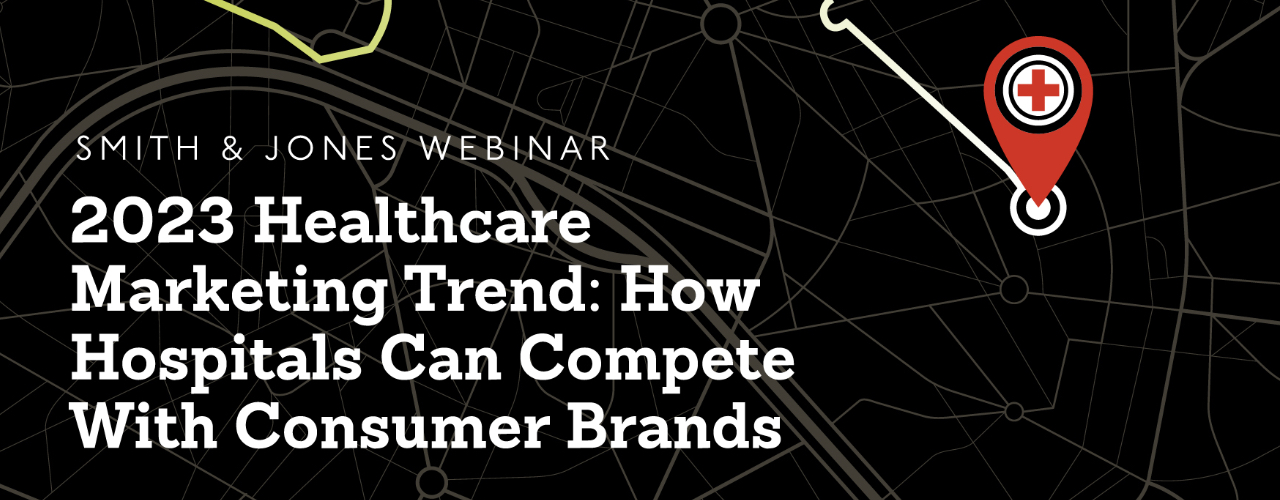How Hospitals Can Compete With Consumer Brands – Recap
As part of our Healthcare Marketing Trends for 2023 webinar series, we dedicated our first deep dive to retail disruptors in the healthcare industry. If you missed the webinar, you can watch it here and we will also go over the key takeaways in this post.
Big names like Walmart, Dollar General, and Amazon are offering basic healthcare services at affordable prices, making the healthcare industry more competitive than ever before.
It’s our prediction that retailers who offer healthcare services will gain traction in 2023. This may seem a little intimidating but we have some insights and strategies that traditional healthcare companies can implement to stay competitive.
Background on our Trends Report
For the past 10 years, we’ve released annual reports on marketing trends for healthcare brands. And with over 30 years of healthcare marketing experience, we have access to some pretty impressive data.
We look at Google Trends, implement surveys and interviews, and foster social listening. We then take all of our insights straight from the sources and present them in an actionable report. We also dedicate a full webinar to each trend that we see surfacing in the healthcare marketing space.
If you want to learn more about the other seven healthcare marketing trends, you can download the report here.
Retailers as Disruptors
Retailers are making significant moves to offer healthcare alternatives. This new ease of access to healthcare is resonating with consumers, especially when you factor in affordability.
Pharmacies are expanding their services to offer more than just medication. Many are now offering diagnostics, telehealth, dental services, and more. This is creating a conundrum for traditional healthcare providers. With all that said, healthcare companies are having to reinvent themselves.
Retailers have the resources to play the long game and compete with traditional healthcare providers. Not to mention, they already know how to please and retain consumers.
Competition is Heating Up
Retailers are offering healthcare for the long haul. Let’s look at some examples.
- CVS spent $8 billion to acquire Signify Health
- Walmart made a 10-year deal with the world’s largest health insurer–United Health Group
- Amazon bought primary care company, One Medical for $3.9 billion
This shows how dedicated these disruptive retailers are and how serious they are about capitalizing on healthcare services.
Consider the Patient Landscape
With insurance premiums rising, consumers are more cost-focused when it comes to healthcare and the affordable options retailers are offering are pretty enticing.
Convenience is another factor contributing to retailers impacting the traditional healthcare landscape. At least half of the population already shops at these major retail locations so it’s a seamless fit to get healthcare at places like Walmart.
Tactics to Stay Competitive
Consumers value both trust and low prices. Retailers have the ability to offer affordable healthcare options but consumers are still a little skeptical. This gives traditional healthcare providers hope. So use your home field advantage and authenticity to compete with these giant retailers. Here are some ideas for building trust and convenience in your community:
- Price transparency
- Home delivery
- Stay away from clichés
- Develop an authentic local image
- Become part of your local community
- Sponsor a cause
- Use recruitment marketing to grow your brand
Conclusion: The Most Important Tool in Your Marketing Toolbox
Your brand is everything. Utilize it to convey trust and transparency. As we mentioned, you have the home-field advantage. Read more about how crucial strong branding is.
What do you do really well? Capitalize on that and implement your strongest assets into your marketing strategy.
Want to learn how Smith & Jones can help your healthcare business succeed against these giant retailers? Contact us today for a free consultation.

